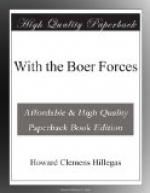The accoutrement of the Boer burgher was none the less incongruous than the physical appearance of the majority of them, although no expensive uniform and trappings could have been of more practical value. The men of the Pretoria and Johannesburg commandos had the unique honor of going to the war in uniforms specially made for the purpose, but there was no regulation or law which compelled them to wear certain kinds of clothing. When these commandos went to the frontier several days before the actual warfare had begun they were clothed in khaki-coloured cloth of almost the same description as that worn by the soldiers whom they intended to fight. These two commandos were composed of town-folk who had absorbed many of the customs and habits of the foreigners who were in the country, and they felt that it would be more warlike if they should wear uniforms made specially for camp and field. The old Boers of the towns and the takhaars looked askance at the youth of Pretoria and Johannesburg in their uniforms, and shook their heads at the innovation as smacking too much of an anti-republican spirit.
Like Cincinnatus, the majority of the old Boers went directly from their farms to the battlefields, and they wore the same clothing in the laagers as they used when shearing their sheep or herding their cattle. When they started for the frontier the Boer farmers arranged matters so that they might be comfortable while the campaign continued. Many, it is true, dashed away from home at the first call to arms and carried with them, besides a rifle and bandolier, nothing but a mackintosh, blanket, and haversack of food. The majority of them, however, were solicitous of their future comfort and loaded themselves down with all kinds of luggage. Some went to the frontier with the big, four-wheeled ox-waggons and in these they conveyed cooking utensils, trunks, boxes with food and flour, mattresses, and even stoves. The Rustenburg farmers were specially solicitous about their comfort, and those patriotic old takhaars practically moved their families and household furniture to the camps. Some of the burghers took two or three horses each in order that there might be no delay or annoyance in case of misfortune by death or accident, and frequently a burgher could be seen who had one horse for himself, another for his camp utensils and extra clothing, and a third and fourth for native servants who cooked his meals and watched the horses while they grazed.




